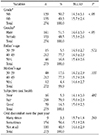Abstract
Objectives
The purpose of this study was to examine oral health literacy in a sample of Korean of 5th and 6th grade elementary school children.
Methods
Data were obtained from a convenience sample of 274 5th and 6th grade children from two elementary schools located in Seoul and Uijeongbu. The oral health literacy assessment tool for children of Korea (OHLC-K) takes approximately 11 minutes to complete, and consists of 20 self-report questions with a score range of 0 to 20. Item analysis, descriptive statistics, correlation and multiple linear regression were performed using SPSS 23.0 and testAn 1.0.
Results
The lowest and highest percentage of correct answers were found in “Definition of periodontal disease (19.3%)” and “Definition of halitosis (92.7%),” respectively. The mean score for oral health literacy was found to be 14.95 ± 2.83, corresponding to a score of approximately 75% correct answers. The correlation coefficient for Korean and OHLC-K scores was high (r=.73, P<.01). In the multiple linear regression, oral health literacy was associated with grade and gender.
Figures and Tables
Table 5
Percentile by scores of Korean and oral health literacy (n=48)

*Korean: Korean items on qualification examination for elementary school degree. Korean and Oral health literacy scores are ranged from 0 to 20. Coefficients of variation; Korean=.12, oral health literacy=.14, Skewness; Korean=−1.85, oral health literacy=−.71, Kurtosis; Korean= 4.32, oral health literacy=−.27.
References
1. WHO. Oral health promotion through schools. WHO information series on school health document 11. Geneva: World Health Organization;2003. p. 7–8.
2. Horowitz AM, Kleinman DV. Oral health literacy: the new imperative to better oral health. Dent Clin North Am. 2008; 52:333–344.

3. Berg JH, Slayton RL. Early childhood oral health. New Jersey: John Wiley & Sons;2015. p. 200–201.
4. Sabbahi DA, Lawrence HP, Limeback H, Rootman I. Development and evaluation of an oral health literacy instrument for adults. Community Dent Oral Epidemiol. 2009; 37:451–462.

5. Ju HJ, Oh HW, Lee HS. A cross-sectional study on oral health literacy and its influencing factors among adults: II. functional oral health literacy. J Korean Acad Oral Health. 2013; 37:81–88.

6. Ju HJ, Lee HS, Oh HW. Relationship of oral health literacy with oral health behaviors among adults. J Korean Acad Oral Health. 2015; 39:186–194.

7. Lee HJ. Development of oral health literacy evaluation tool for Korean adult [dissertaion]. Jeonju: Chonbuk National University;2017. [Korean].
8. Ahn EJ, Kwon IS. Health literacy of elementary school students. Child Health Nurs Res. 2014; 20:322–331.

9. Jang BS, Kim DH. Health Literacy and Health Behavior in Late School-age Children. J Korean Acad Community Health Nurs. 2015; 26:199–208.

10. Hong J, Shin Y, Chang KW. Development of oral health literacy assessment tool for fifth and sixth grade elementary school students. J Korean Acad Oral Health. 2017; 41:214–221.

11. Kim KH. Setting achievement levels and classification consistency on the national assessment of educational achievement. J Educ Eval. 2005; 18:1–17.
12. Hong SY. The comparison for the standard setting methods of the assessment of educational achievement in elementary school using the modified Angoff and Bookmark methods. J Learn Cent Curric Instr. 2011; 11:495–523.
13. Seong TJ. Modern educational evaluation. 4th ed. Seoul: Hakjisa;2010. p. 353–359.
14. Kelley TL. The selection of upper and lower groups for the validation of test items. J Educ Psychol. 1939; 30:17–24.

15. Hahn DD, Gill IJ. A survey study on the characteristics of friend relations and their development across upper grades in an elementary school. J Elementary Educ. 2016; 29:257–280.
16. Kim TK, Lee PY, Chang KH. The relation between age/gender and MLU in Korean. Korean Lang Lit Int Context. 2006; 38:107–124.
17. Lee SH, Choi EHR, Je MJ, Han HS, Park BK, Kim SS. Comparison of two versions of KHLAT for improvement strategies. J Korean Soc Health Educ Promot. 2011; 28:57–65.
18. Jung SH, Kim YN, Ru JI, Park WS, Bae KH, Bae SM. Strengthening strategies of oral health program throughout lifecycle. Ministry for Health, Welfare and Family Affairs, Korea Institute for Health and Social Affairs;2006. p. 5.
19. Ministry of Health and Welfare. 2016 The Korea youth risk behavior web-based survey. Ministry of Health and Welfare;2016. p. 53.
20. Ju HJ, Oh HW, Kim JY, Lee HS. A cross-sectional study on oral health literacy and its influencing factors among adults: I. verbal oral health literacy. J Korean Acad Oral Health. 2012; 36:97–105.
21. Kripalani S, Weiss BD. Teaching about health literacy and clear communication. J Gen Intern Med. 2006; 21:888–890.

22. Bridges SM, Parthasarathy DS, Wong HM, Yiu CKY, Au TK, McGrath CPJ. The relationship between caregiver functional oral health literacy and child oral health status. Patient Educ Couns. 2014; 94:411–416.

23. Kang YM, Cho YS. Impact of mother’s oral health literacy on preschool children’s oral health status and behavior. J Dent Hyg Sci. 2016; 16:26–36.

24. Khodadadi E, Niknahad A, Sistani MMN, Motallebnejad M. Parents’ oral health literacy and its impact on their children’s dental health status. Electron Physician. 2016; 8:3421–3425.

25. Vann WF Jr, Lee JY, Baker D, Divaris K. Oral health literacy among female caregivers: impact on oral health outcomes in early childhood. J Dent Res. 2010; 89:1395–1400.
26. Miller E, Lee JY, DeWalt DA, Vann WF Jr. Impact of caregiver literacy on children’s oral health outcomes. Pediatrics. 2010; 126:107–114.

27. Kim JY, Suk MH. Health literacy and health promoting behaviors in adolescents. J Korean Public Health Nurs. 2016; 30:570–582.

28. Kim SW SH, Yoon JC, Lee KK, Jung GJ, Lim SI. The foundation of the National Literacy Survey. Seoul: The National Institute of the Korean Language;2008. p. 117.




 PDF
PDF ePub
ePub Citation
Citation Print
Print








 XML Download
XML Download